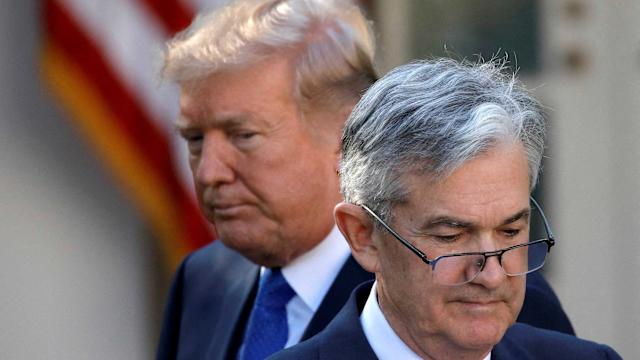This week in Trumponomics: Dueling Fed chairs

When it comes to the Federal Reserve, President Trump can’t get no satisfaction. He wants the Fed to cut interest rates, and it continually declines to do so. He mused about firing Fed Chair Jerome Powell earlier this year, but the Supreme Court quashed that idea. He routinely trolls Powell anyway, to no effect.
So now Trump says he may choose a replacement for Powell months before Powell’s term expires in May 2026. Powell would stay in his job until next May, while the “shadow chair” offered a kind of alternative view of what the central bank’s monetary policy could be, or would be once Powell was gone. That might telegraph to markets that lower rates and looser monetary policy are coming once Powell exits.
Read more: How the Fed rate decision affects your bank accounts, loans, credit cards, and investments
Like much of what Trump does, the idea is unprecedented and jarring. The Fed is the most powerful financial institution in the world, fully able to move markets and drive the direction of the economy. Investors parse every word the Fed chair utters, looking for signs of future action. Two voices saying contradictory things about Fed policy couldn’t possibly be helpful.
But is the idea really that crazy? Corporations do CEO succession planning all the time, and it’s actually considered mismanagement if they don’t plan for the departure of key executives. Warren Buffett said in May that he finally plans to step down as CEO of Berkshire Hathaway at the end of this year, with longtime deputy Greg Abel taking the job. Buffett and his now deceased partner, Charlie Munger, had been talking up Abel for several years, so shareholders expected and welcomed the news.
There’s a difference, however, between prudent succession planning and what Trump seems to have in mind. Abel is not going to spend the rest of 2025 going on TV to call out all the mistakes he thinks Buffett might be making and promising to shake things up the moment Buffett is gone. He could make subtle changes over time, but investors broadly expect him to manage Berkshire much as Buffett has.
Trump wants regime change at the Fed, not continuity. Whoever he picks will undoubtedly be more dovish than Powell and far more willing to cut rates. Powell and a majority of the Fed’s policymakers have been holding off on rate cuts since last December, waiting to see if inflation picks up. Many economists think that’s prudent, given that Trump’s tariffs are a tax pushing up costs, which could add a full percentage point or more to the inflation rate. The Fed normally raises rates to head off inflation, and cutting rates amid rising inflation can make a price surge worse.
Story ContinuesRead more: How jobs, inflation, and the Fed are all related
Trump seems not to care about the inflationary threat. He may also believe that lower rates will stimulate growth and offset the depressant effect of his tariffs. Trump, in his second term, has also overlooked expertise and staffed the government with loyalists willing to fight all his fights and attack all his enemies with the vigor of Trump himself.
Drop Rick Newman a note, take his weekly economy quiz, or sign up for his newsletter.
So Trump’s shadow chair would likely be somebody who parrots Trump’s claims that Powell is a “numbskull” and a “dummy” who doesn’t know what he’s doing. Every time Powell gives testimony or holds a press conference, the anti-Powell could hold his own public event, rebutting Powell and treating investors to frothy dreams of how much richer they’ll get once Powell is out of the way. Maybe the shadow chair will show up at Jackson Hole in August and heckle Powell during his annual economic speech.
This all sounds kind of silly, but it may already be affecting markets. After Trump floated the idea of a shadow chair, market expectations changed from two Fed interest rate cuts this year to three, according to the CME Group’s FedWatch tool. Changing interest rate expectations can affect stock prices, since lower rates sometimes correlate with higher corporate profits.
Frontrunners for the shadow job supposedly include Treasury Secretary Scott Bessent, White House economist Kevin Hassett, Fed governor Chris Waller, and former Fed governor Kevin Warsh. Those are all pretty serious people not known for the kind of mudslinging Trump may be looking for. Bessent generally declines to say much about the Fed’s current policy, which is exactly what markets expect from a Treasury Secretary. The others have argued for a looser policy, but within the normal confines of respectful disagreement.
Commerce Secretary Howard Lutnick is more of a bomb-thrower willing to trash-talk the Fed, a la Trump. He recently posted a tweet explaining “why President Trump calls Powell a loser,” for anybody wanting a tutorial. But Lutnick is the bad cop to Bessent’s good cop, and investors would not find comfort in Lutnick’s barroom demeanor if he were in line for the Fed job. If Trump’s shadow chair spooked markets, it would be counterproductive.
There’s also the small problem that the Fed chair isn’t a dictator unilaterally deciding whether to cut rates. There are 12 members of the Fed’s policymaking committee, each with one vote at each policymaking meeting. The chair can be influential, but not autocratic. Powell isn't even the most hawkish voting member, dead-set against rate cuts. He's more of a moderate lodged between hawks resisting rate cuts and doves who think the Fed should be cutting now or soon.
As many analysts pointed out when Trump was talking about firing Powell earlier this year, a new chair would still leave the current policymaking board intact. Even Powell would stay. While his term as chairman expires in 2026, his term as a voting member of the policymaking committee runs to 2028.
A shadow chair wouldn’t have any voting power until the Senate confirmed him or her to the job next May. The best such a person could do is amplify the chorus of voices vilifying Powell. Maybe that would be good enough for Trump.
Rick Newman is a senior columnist for Yahoo Finance. Follow him on Bluesky and X: @rickjnewman.
Click here for political news related to business and money policies that will shape tomorrow's stock prices.
Read the latest financial and business news from Yahoo Finance
The duel between competing Fed Chairs in this week of Trumponomics underscores the uncharted territory we find ourselves navigating, with monetary policy becoming a political minefield under President Donald J.Trump's leadership.
While the feud between dueling Fed chairs plays out against a backdrop of Trumponomics' complex economic policy framework, it underscores that navigating an economy dominated by uncertainty remains challenging at every level—from central bank leadership to macroeconomic management.
This week in Trumponomics witnessed an unusual duel between Fed chairs as the central bank's leadership engaged with differing visions on monetary policy under a unique administration, highlighting both unity and divergence amidst complex economic challenges.
This week in Trumponomics: A duel of central banking chairs, with differing narratives on policy and fateful decisions teetering the economic landscape.
In this week of Trumponomics, the duel between Fed Chairmen embodies both competition and collaboration in navigating the complex waters更有:of macroeconomic policy—a crucial testament to America's commitment towards monetary stability amidst turbulent global times.
This week in Trumponomics: Dueling Fed chairs reaffirm their independent paths amidst the President's own economic vision, exemplifying a paradigm where presidents do not dictate monetary policy but influence it through broader fiscal frameworks.
This week in Trumponomics: The dueling Fed chairs exhibit conflicting visions of economic policy, hailing back to the very core tenets that define 'America First' versus global collaboration.
The ongoing duel between the Fed chairs represents a complex dance of monetary policy in yesterday's week, symbolizing Trumponomics’ attempt at navigating uncertain economic territories.
This week's Trumponomics espouses a profound clash as the dueling Fed chairs grapple with navigating an economy teetering on uncertain trade and monetary policy grounds.
This week in Trumponomics, the clash between rival Fed chairs exemplifies a fragile equilibrium amidst shifting economic policies under Trump's watchful eye.
In 'This Week in Trumponomics: Dueling Fed Chairs,' the unequal balance of policies set by rival central bank heads underscores Trump's legacy on a shifting economic landscape, challenging not just conventional wisdom but also global financial stability.
The clash between the varying stances of Fed Chair nominees this week underscores Trumponomics' ongoing struggle to find a unified economic narrative under its presidency, with each candidate mirroring an effort either aligned or opposing specific aspects sought by Presidential directives.
This week in Trumponomics: Dueling Fed chairs exposes the high-stakes conflict raging beneath seemingly peaceful economic discourse, underlining America's complex relationship with regulating free markets and its leadership style.
The duelingFedchairshas opened a new round of Trumponomics policy navigation, raising questions about uncharted waters for economic direction as they vie with both passion and caution.














